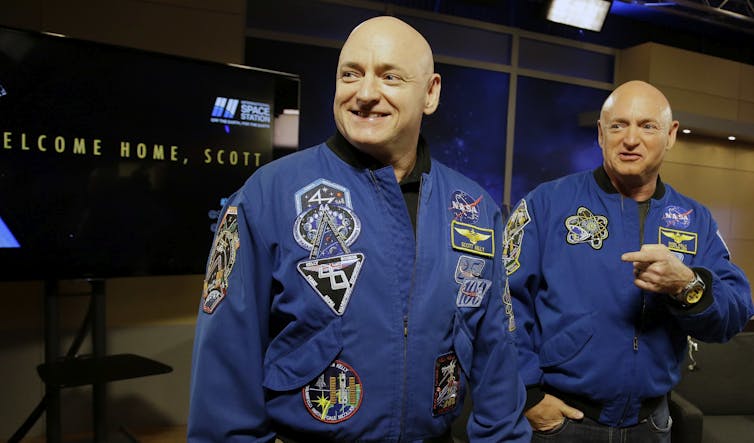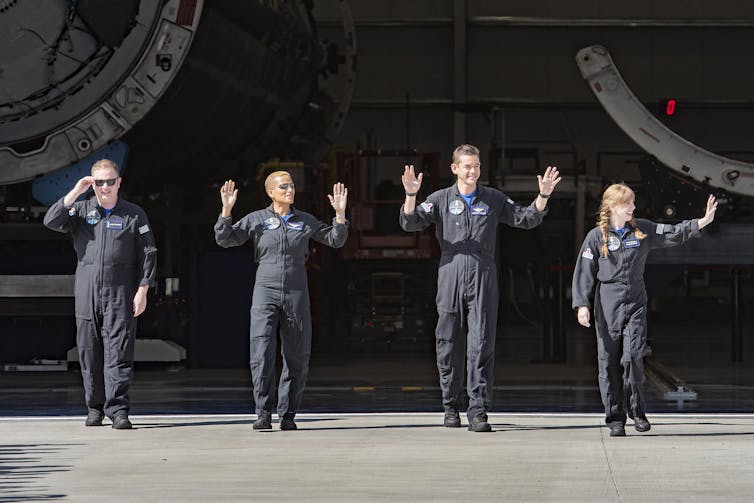Only about 600 people have traveled into space. The vast majority of astronauts over the past six decades have been middle-aged men on short-duration missions of less than 20 days.
Today, with the arrival of private, commercial and multinational spaceflight providers and companies, we are witnessing a new era of human spaceflight. Missions lasted from minutes, hours and days to months.
As humanity looks to return to the Moon in the next decade, space exploration missions will be much longer, with many more space travelers and even space tourists. This also means a greater diversity of people will experience the extreme environment of space – more women and people of different ethnicities, ages and health conditions.
Individuals respond differently to space-specific stressors and exposures. That’s why space health researchers like me are working to better understand the effects of spaceflight on human health. With this information, we can determine how to help astronauts stay healthy while in space and once they return to Earth.
As part of NASA’s landmark twin study, in 2019 my colleagues and I published groundbreaking research on how a year aboard the International Space Station affects the human body.
I am a radiation cancer biologist in the Department of Environmental and Radiological Health Sciences at Colorado State University. I have spent the last few years following up on this earlier research in a series of papers recently published in the Nature portfolio of journals.
These articles are part of the Space Omics and Medical Atlas of manuscripts, data, protocols, and repositories, which represents the largest collection ever assembled in the field of aerospace medicine and space biology. More than 100 institutions from 25 countries have contributed to the coordinated dissemination of a wide range of spaceflight data.
NASA’s Twin Study
NASA’s twin study seized a unique research opportunity.
NASA selected astronaut Scott Kelly for the agency’s first one-year mission, during which he spent a year aboard the International Space Station from 2015 to 2016. During the same period, his twin brother, Mark Kelly, a former astronaut and current U.S. senator representing Arizona, remained on Earth.

Photo AP/Pat Sullivan
My team and I examined blood samples taken from the twin in space and his genetically matched twin on Earth before, during, and after spaceflight. We found that Scott’s telomeres—the protective caps at the ends of chromosomes, much like the plastic tip that keeps a shoelace from fraying—lengthened, quite unexpectedly, during his year in space.
Upon his return to Earth, his telomeres rapidly shortened. Over the next few months, they recovered, but they were still shorter after his trip than before he went to space.
As you age, your telomeres shorten due to a variety of factors, including stress. The length of your telomeres can serve as a biological indicator of your risk of developing age-related diseases such as dementia, cardiovascular disease, and cancer.
In a separate study, my team studied a cohort of 10 astronauts on a six-month mission aboard the International Space Station. We also had a control group of age- and gender-matched participants who remained on the ground.
We measured telomere length before, during, and after spaceflight and found once again that telomeres were longer during spaceflight and then shortened upon return to Earth. Overall, astronauts had significantly more short telomeres after spaceflight than before.
One of the other researchers in the twin study, Christopher Mason, and I conducted another study of telomeres – this time with twins who were high-altitude mountaineers – a somewhat similar extreme environment on Earth.
We found that when climbing Mount Everest, the climbers’ telomeres were longer, and after they descended, their telomeres shortened. Their twins who remained at lower altitudes did not experience the same changes in telomere length. These results indicate that it was not the microgravity of the space station that led to the telomere length changes we observed in the astronauts. Other culprits, such as increased radiation exposure, are more likely.
Civilians in space
In our latest study, we looked at the telomeres of the crew of SpaceX’s Inspiration4 mission in 2021. This mission included the first all-civilian crew, whose ages spanned four decades. All crew members’ telomeres lengthened during the mission, and three of the four astronauts also showed telomere shortening once they returned to Earth.

SpaceX, CC BY-NC
What’s particularly interesting about these results is that the Inspiration4 mission lasted only three days. So not only do scientists now have consistent and reproducible data on the telomere response to spaceflight, but we also know that this response occurs rapidly. These results suggest that even short trips, such as a weekend getaway to space, will be associated with changes in telomere length.
Scientists still don’t fully understand the health effects of these changes in telomere length. More research is needed to determine how long and short telomeres can affect an astronaut’s long-term health.
Telomeric RNA
In another paper, we showed that the Inspiration4 crew – as well as Scott Kelly and high-altitude climbers – had increased levels of a telomeric RNA, called TERRA.
Telomeres are made up of many repetitive DNA sequences. These are transcribed into TERRA, which contributes to the structure of telomeres and helps them do their job.
Combined with laboratory studies, these findings tell us that telomeres are damaged during spaceflight. While there is much we don’t know, we do know that telomeres are particularly susceptible to oxidative stress. So the chronic oxidative damage astronauts experience when they are exposed to space radiation 24 hours a day likely contributes to the telomeric responses we see.
We also wrote a review paper with a more futuristic perspective on how a better understanding of telomeres and aging could begin to shed light on the ability of humans not only to survive long-duration space travel, but to thrive and even colonize other planets. To do this, humans would have to reproduce in space and future generations would have to grow up in space. We don’t even know if that’s possible—yet.
Plant telomeres in space
My colleagues and I have also contributed to other work in the Space Omics and Medical Atlas program, including a paper published in Nature Communications. The research team, led by biologist Dorothy Shippen of Texas A&M and biologist Sarah Wyatt of Ohio University, found that, unlike humans, plants transported to space did not have longer telomeres while aboard the International Space Station.
The plants, however, increased their production of telomerase, the enzyme that helps maintain telomere length.
As anyone who has seen “The Martian” knows, plants will play a vital role in humanity’s long-term survival in space. This discovery suggests that plants may be more naturally adapted than humans to withstand the stressors of space.